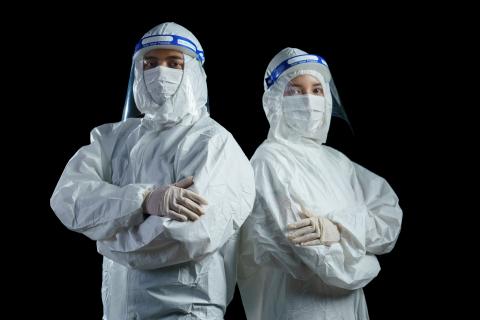Personal protective equipment (PPE) is used by people to protect them from hazards. Hazards may include those that occur in the workplace, such as laboratories, hospitals, construction areas, and factories. Personal protective equipment may also be used in recreational activities, such as going on zip lines, sailing, rock climbing, sky diving, and sports. PPEs protect eyes, hands, respiratory organs, heads, torsos, and other parts of the body. How do these PPEs protect people?

Goggles, gloves, and lab coats protect scientists and medical personnel from chemical spatter, microorganisms, and other biohazards. Helmets protect the brain from serious injuries and are worn in sports, motorcycling, biking, and activities that may have the potential to cause head injury. Special bulletproof vests are worn by some law enforcement professionals to keep them safe on the job where they may encounter dangerous bullets or other projectiles. Various forms of masks keep germs and toxic chemicals away from nasal passages and the lungs. Divers wear special suits to keep them dry and warm. A special type of suit for deep-sea diving is made like a one-person submersible to help withstand water pressure at great depths.
The dangers in space require that astronauts wear special suits for protection. There are two kinds of spacesuits that astronauts wear. One kind is worn during lift-off and again on re-entry into Earth’s atmosphere. The other one is specifically designed and worn during spacewalks. Spacewalkers face the dangers of radiation, extreme temperatures, and space debris. The suit spacewalkers wear is shaped like the human body but is a miniature spaceship. It is called the Extravehicular Mobility Unit or EMU. It allows the astronaut to work outside the spacecraft where temperatures may range from -250 degrees Fahrenheit to 250 degrees. The spacesuit contains 300 feet of water tubes to regulate body temperature. The other pieces have flexible parts that contain as many as 16 layers of material. A bladder layer is filled with gas to maintain the proper pressure for the body and holds oxygen for breathing. Other layers act as insulators and are water and fire-resistant. The helmet is made of strong plastic to keep pressure in. It has a sun visor to protect the astronaut’s eyes from radiation. It also contains a communication system that allows the astronaut to talk to other astronauts and to mission control.1

We live in an environment where sin abounds. It is full of dangers to our spiritual and physical lives. We are not dealing with human enemies but against the powers of darkness and forces of evil. Temptations come in several forms, some seemingly innocuous, and even pleasurable. Sin will result in terrible consequences for us.
Call to Action: Wearing God’s Personal Protective Equipment
To survive we need to wear personal protective equipment—the whole armor of God. God’s armor includes the belt of truth, the breastplate of righteousness, the shoes of the gospel of peace, the shield of faith, the helmet of salvation, and the sword of the Spirit (Ephesians 6:14-17 NIV).
Let us ask the Holy Spirit to guide us into truth and to convict us of wrongdoing. Let us seek and spend time in prayer and communion with God and fortify our faith by studying the Word of God. Let us accept God’s gift of salvation and open our hearts and homes to the Holy Spirit every day of our lives.
“Finally, be strong in the Lord and in his mighty power. Put on the full armor of God so that you can take your stand against the devil’s schemes.”
Ephesians 6:10-11 NIV

All Scripture quotations are taken from the Holy Bible, New International Version®, NIV®. Copyright ©1973, 1978, 1984, 2011 by Biblica, Inc.™ Used by permission of Zondervan. All rights reserved worldwide.
- Erin Mahoney, editor. “Spacewalk Spacesuit Basics.” Update July 17, 2020. https://www.nasa.gov/feature/spacewalk-spacesuit-basics.




